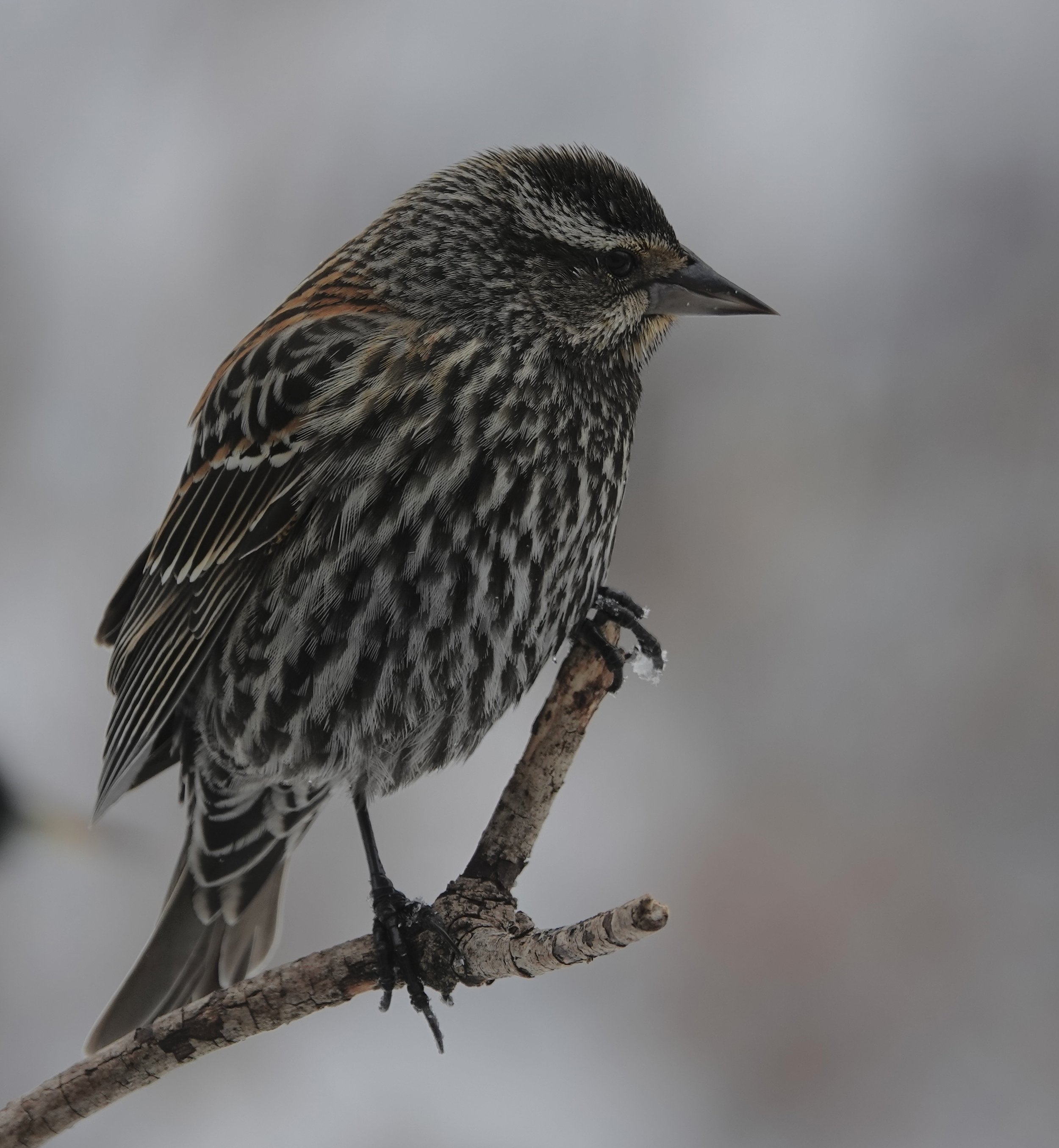A female red-winged blackbird. Sexual dimorphism refers to observable differences between males and females of the same species, meaning a female of a species is easily distinguished from a male. Photo by Al Batt
Naturally
I heard the soothing call of a mourning dove.
Teddy Roosevelt heard that call, too. During his presidency (1901 to 1908), he helped establish 51 preserves for birds, five national parks, 18 national monuments and 150 national forests. He took time to list the 91 bird species he saw or heard on the White House grounds. In 1908, he compiled a list of 93 species of birds he saw in Washington, D.C., during his presidency.
My family was in Kansas to watch one member play in an NCAA basketball tournament. The natural landscape of the state didn’t impress most of those travelers. I, on the other hand, revel in the beauty of Kansas. My favorite spot is Cheyenne Bottoms, a natural geologic depression north of the Arkansas River in the center of the state not far from Great Bend. Approximately 45% of the North American shorebird population stops at the Bottoms during spring migration. At least 320 species of birds have been recorded there. Quivira National Wildlife Refuge is another favorite haunt of mine.
Happiness comes in flocks. I heard the red-winged blackbirds calling, “Look at me.” The jubilant voices, a paean to spring, might even include, “I know you are, but what am I?” The red-winged blackbird is a polygynous species, meaning males have many female mates, with up to 15 females nesting in one territory. A successful male has a good territory, so he hurries home to claim it. Males migrate before the females in spring and after the females in fall.
I saw an ermine last winter. Weasels are brown in the summer and turn white in the winter. The short-tailed weasel is also called an "ermine" and is known for its fur, which sometimes became the trim on coats. I’d rather see one than wear it.
Q&A
“What bird is the loudest?” White bellbirds live in the high mountains of northern Brazil and southern Venezuela. Their shattering calls reach up to 125 decibels. That approximates the volume experienced by those sitting in the front row of a rock concert.
“How fast do antlers grow?” A white-tailed deer's antlers grow as much as a quarter-inch per day. Elk antlers grow as much as 1 inch a day and a moose can add 1 pound of new antler growth every day.
“Do ultrasonic/electronic mice repellers work?” Between 1838, when the United States Patent Office opened its doors, and 1996, over 4,400 mousetrap patents were awarded. Researchers advise against buying ultrasonic devices. Consumer Reports said there is no proof they work, but this doesn’t stop companies from making claims. The FTC has investigated several sonic repellent makers for false advertising.
“Do cedar waxwings migrate?” Considered a short-distance migrant, their winter movements are irregular, responding to the availability of food. They are erratic in abundance and distribution, but I see some each winter.
“How do turtles survive winter?” Freshwater turtles retreat underwater where temperatures are stable and above freezing. Most are inactive, buried in mud at the bottom of lakes and rivers, but some remain active in slow motion. The cold minimizes the turtle’s oxygen needs. While underwater, the turtle exchanges oxygen and carbon dioxide with the water through the turtle’s skin or across the membrane lining its throat. It stores a sugar called glycogen in all its organs. Glycogen can serve as an energy source without using oxygen.
“How can I tell which redpolls are males?” A common redpoll has a red forehead patch, black feathering around a yellow bill, and two white wingbars. Males have a pale red vest. A redpoll has an expandable pouch in its throat that enables the storage of seeds to eat elsewhere. The redpoll can tunnel into the snow overnight for warmth.
“Should I prune branches bearing tent caterpillars and burn them?” Eastern tent caterpillars are found on fruit trees like apple, chokecherry, crabapple, plum and cherry in May and June. They make a noticeable web or tent in the fork of the branches. Fall webworms create a large webbing at the ends of the branches of walnut, birch, black cherry, elm and maple trees in late July through September. There is no need to prune. You could soak the tents with soapy water or pull out the webbing along with the caterpillars. Bury or bag to dispose of them.
“I saw a big bee at the end of winter. What kind was it?” It was likely a bumble bee (Minnesota has 24 species), which is a bee that overwinters as a fertilized queen.
Thanks for stopping by
“We are not an endangered species ourselves yet, but this is not for lack of trying.”—Douglas Adams.
“It is wrong always, everywhere, and for anyone, to believe anything upon insufficient evidence.”—William Kingdon Clifford.
Do good.
©Al Batt 2022
A kind reader from Illinois, after reading of my boyhood use of recycled catalogs and peach papers in our outhouse, sent me a roll of bamboo toilet paper. The packaging proudly proclaims it hangs over and under.
This aerial photo of Montana shows that the state raises a lot of barley.
Joy Behr of Albert Lea, MN, worked her magic on this. This lovely wall hanging is stationed by an elevator where it brightens the days of those on their way up and those on their way down.
Words on birds on the radio.
A skunk sat on a stump
And thunk the stump stunk,
But the stump thunk the skunk stunk.
A small book written to highlight the plight of the roughly 90,000 giraffes that populate the world.







